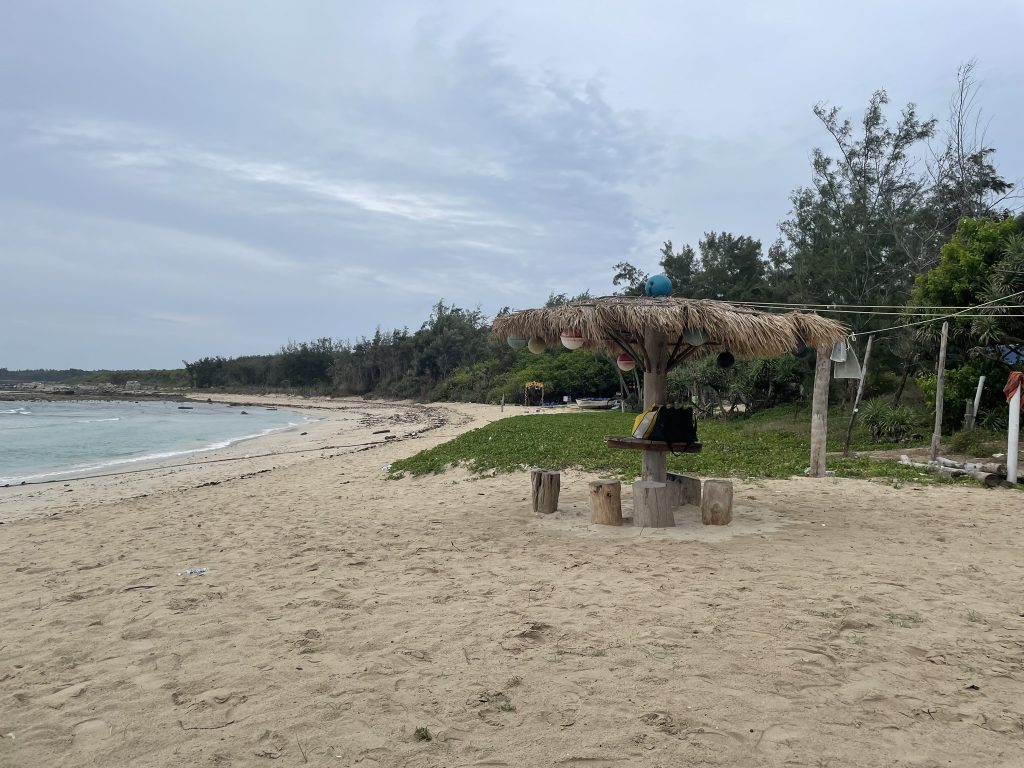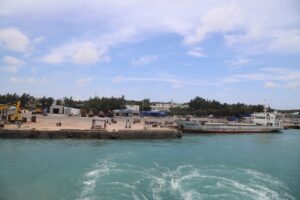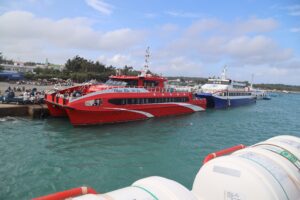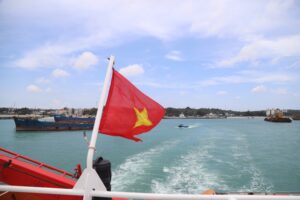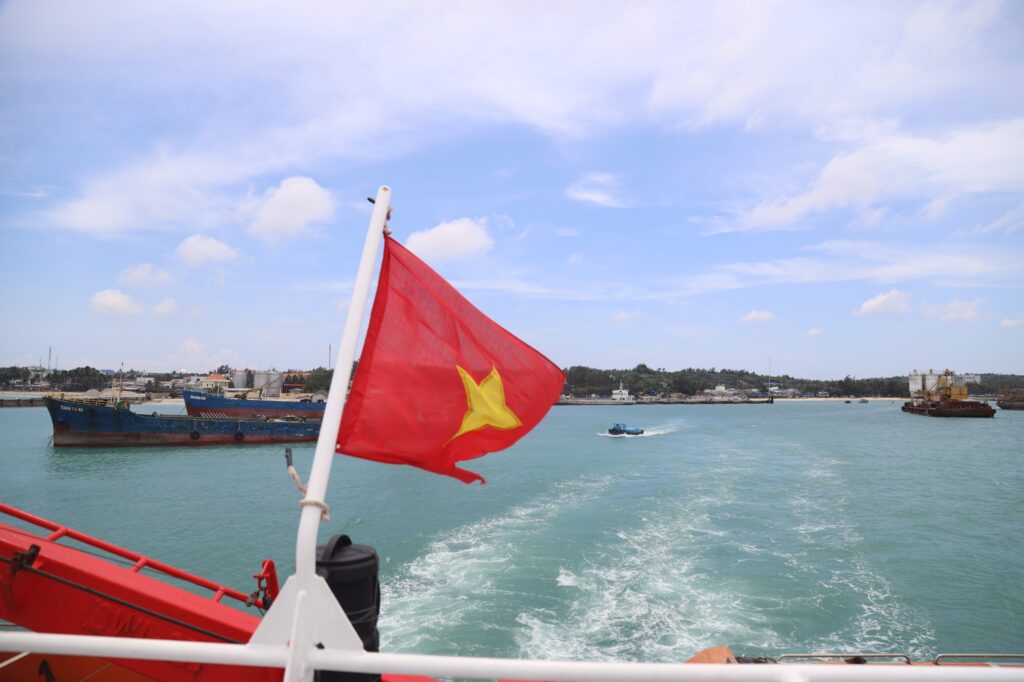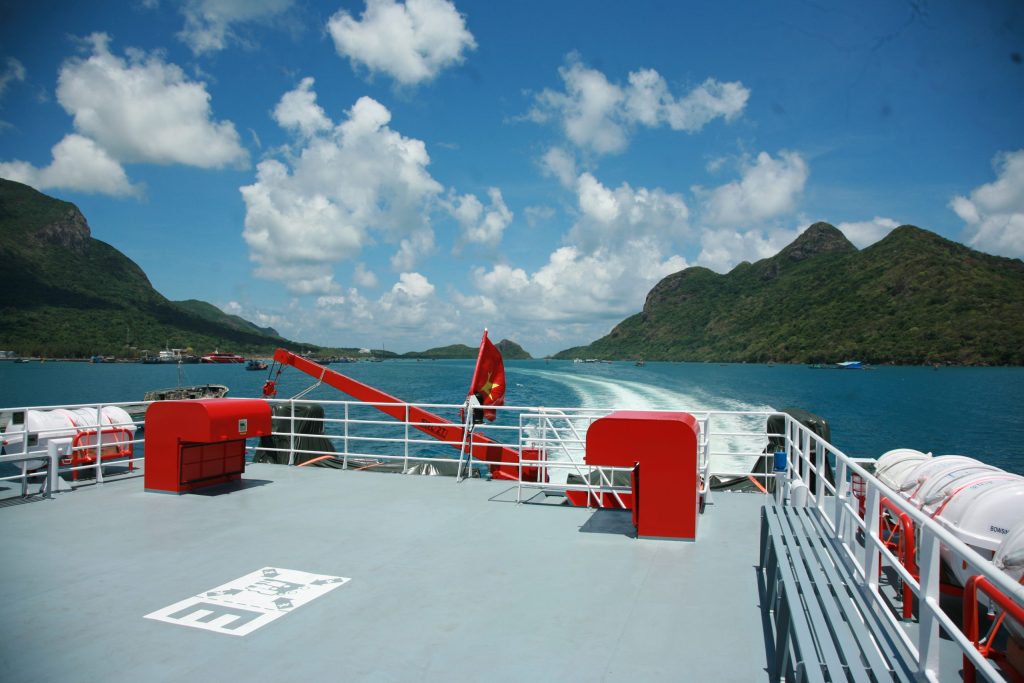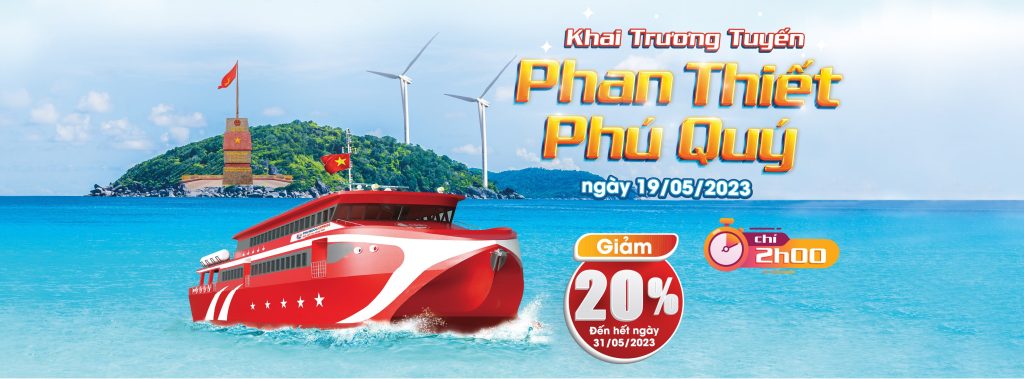Hon Tranh is the largest odd island in the population of small islands in Phu Quy, about 1.5km southeast of the big island. Hon Tranh has a shape like the letter S, an area of 2.8 km2, the widest place is 400m and the longest place is 1,000m. Previously, this island was a deserted island with overgrown Tranh grass, so it was called Hon Tranh. It takes about 30 minutes from the big island of Phu Quy to Hon Tranh.
In the past Hon Tranh was determined to be an outpost island, on the island mainly army barracks stationed and only a few households lived for a long time.
Beautiful views of Hon Tranh island from a distance with green trees, looking to the West, we see the lava block traces of previously active volcanoes creating the strange and beautiful shapes; Coming to this position, we can admire the natural beauty from above, looking down the panoramic view of “Buddha puddle” with mysterious and magical red and black lava blocks.
Hon Tranh is surrounded by high mountain slopes, so the sea here is quiet, with few big waves. Especially, the water is always so blue that it can be seen at the bottom, that’s why the corals here are very developed with all different colors, creating an extremely rich and lively underwater ecosystem.
Many tourists come here take advantage of diving to watch the coral and immerse themselves in the cool sea water. The rocks here are also the ideal environment for small fish to lurk. For that reason, you cannot ignore the fun of fishing when coming to Hon Tranh, you will surely get a very attractive booty.
According to the legend of the islanders, during the battles with the Tayson insurgent army, after the defeat, Nguyen Anh and the generals and soldiers often fled to Phu Quy island to shelter, on the Hon Tranh island still keep some relics related to Nguyen Anh and his retainers, including a freshwater well known by the islanders as “Gia Long” well to commemorate Nguyen Anh’s days with his retainers that they used to stay and use the water in this well for daily life. The well is 7m deep, built of coral stone, the wall of the well is 80cm high and 1.2m in diameter.
On Hon Tranh island, there is Tran Bac temple built in the early 19th century. On the altar of Gods in the Great hall of the shrine, there are 2 ancestral tablets of Bui Quan Cong and goddess Thien Y A Na. The content of the ancestral tablet of Bui Quan Cong is as follows: Cung thỉnh Trấn Bắc quân Đô đốc phủ Chưởng phủ sự Thái bảo Bùi Quận công Thượng đẳng thần. Temporary translation: We invite the god of high rank Bui Quan Cong who is Tran Bac army of Admiral of Chuong palace of Thai bao palace to rest in peace. Based on the ancestral tablet, it is possible to identify “Mr. Tran Bac”, whose his surname is Bui, the position of Admiral of Chuong palace of Thai bao Quan cong palace. According to Dai Nam pre-border biographies, the title of Admiral of Chuong palace of Thai bao Quan cong palace was given to Bui Ta Han. And people who loved him gave him the name “Mr. Tran Bac” – who was famous for having rule in peace and exploitage of the land of Quang Nam in the 17th century.
Mr Tran Bac Temple is located to the North of Hon Tranh Island, with the main direction looking to the southwest. The overall architecture of the temple includes the following items: the main gate, the Great hall, the fume house and the shrine of Nam Hai god (whale). In general, the architectural items here are solidly built and ancient moss. The interior Center of the Great hall places 3 altars, the middle one worshiping Tran Bac and Thien Y A Na, two on the left and right worshiping Tien Hien and Hau Hien.
To the right of the Great hall of Tran Bac Temple, lying backwards to build a shrine of Nam Hai god (whale) with an area of 4.5m width x 3.55m wide and inside, there are 72 whale skeletons drifting on Hon Tranh island from past to present.
According to the legend of the slanders, that year for unknown reasons, at the same time, 72 whales died and drifted on Hon Tranh Island. The local people performed the funeral, then built mausoleums and invited remains of the 72 above-mentioned persons to worship. Behind the Great hall worshiping Tran Bac is the fume house, which was simply constructed to serve as a place for cooking offering to worship in the ceremonies at the temple.
The kings of the Nguyen dynasty conferred 3 ordinations to Admiral of the North Army with the title “Khuông quốc Tĩnh biên Mậu công Huy liệt Trác vĩ Bắc quân Đô đốc phủ Chưởng phủ sự Thái bảo Trấn phủ quân Thượng đẳng thần” and instructed to 3 villages Hoi An, Trieu Duong, My Khe to worship.
In which, there was an ordinations of the reign of King Dong Khanh in the second year to confer to Admiral of the North Army and god Nam Hai Cu toc Ngoc lan. All ordinations are kept at An Thanh temple, until the day of worshiping at Tran Bac temple, a procession of ordination will be held from An Thanh temple to the temple to sacrifice and then the procession of returning to An Thanh temple was held to worship.
At Tran Bac temple every year, two main rituals are performed on March 12 to worship Thien Y A Na (Jade Queen) and on August 7 of the lunar calendar to worship Mr. Tran Bac. Every year, on the occasion of Te Xuan Festival, Te Thu Festival and Great grandfather’s death anniversary on October 15 of lunar calendar held at An Thanh temple, the people often make vows to the temple beside Hon Tranh to invite him to attend. The shrine to worship him in Hon Tranh is said to be very miraculous, anyone who acts disrespectfully, will be reprimanded and only forgiven if knowing remorse.
Therefore, people around the area often come to burn incense, pray for good weather, peaceful sea trips and a good fish season.
Coming to Hon Tranh, visitors can enjoy the beautiful natural scenery, green trees, fresh cool air all year round; as well as walking along the island to see corals, fishing… Coming to this small island, visitors also hear stories about Nguyen Anh when being chased by the Tay Son army and hiding here; as well as hear about Bui Ta Han and the miracle of Tran Bac Temple in the cultural and spiritual life of the people on Phu Quy island.



